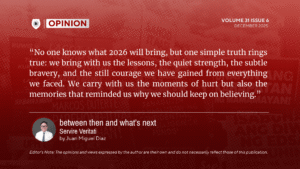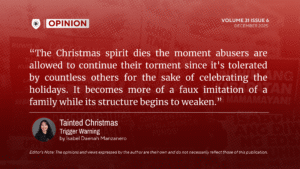By Julianne Maye Sembrano | June 27, 2025
Tiktok Made Me Buy It— But at What cost?
HAVE you ever gone on TikTok during your nightly bedtime social media scroll and been bombarded with a barrage of video content that shows Filipinos going to different countries, holding multiple bags of designer brands, and eating out in BGC or Salcedo Village? And then you mentally think to yourself, ‘I wish that was me.’ Because yes, you wish that were you, and everyone else in the comments thinks so too. Multiple anonymous commenters from around the country also flex in said comment section, ‘The bill when we ate out at Wolfgang Steakhouse reached 250,000 pesos!’ or ‘My mom bought me 7 different labubus when we went to the Popmart Store!’ And that is exactly where this conversation begins.
In today's digital landscape, flex culture has sadly taken center stage and taken up a huge chunk of the current trend of videos we watch today. From watching influencers showing off hundred-thousand-peso hauls from designer stores, jumping from Tokyo to, Bangkok, and finally to Seoul in the span of two months, upgrading to the newest iPhone every year as soon as the new one releases, and joining the latest anik-anik blind box toy craze—where each “unboxing” is worth more than our minimum wage of P645 a day. And in some cases, it's not just influencers. Even the youth have joined the trend in flexing their school supplies bought from National Bookstore.
While there's nothing inherently or morally wrong with sharing one's blessings and posting them publicly, the issue lies in the sustained glorification of a lifestyle that is not only unsustainable but often fictional and superficial. I hold your hand as I say this, here is the hard but well-intentioned truth: not everyone flexing online is actually rich. Some are deep in credit card debt, maxing out loaning apps like Ggives or Juanhand, or quietly asking relatives abroad for cash to keep up the image under the guise of doing this in order to appear approachable and desirable to others.
The true danger begins when this curated lifestyle becomes the baseline and the newfound standard. For many impressionable teens and young professionals who are just starting in the workforce, these posts aren’t just content—they become life goals. Suddenly, success isn’t about finding purpose or building stability; it’s about having the latest iPad, wearing New Balance 530s and Oncloud Shoes to school, and being able to say, “We had dinner at Okada” without blinking at the ₱9,000 bill, meant to help sustain a 5-member family for an entire month, as stated by the National Economic and Development Authority (NEDA).
This fuels a distorted, romanticized view of success tied directly to consumption. And behind that? An everlasting obsession with the American dream—the belief that life only gets better when you have more. More clothes. More gadgets. More likes. This mindset feeds into our country's long-standing crab mentality—we don’t just want to succeed; we want to succeed visibly, and faster than everyone else.
But real life isn’t a Capcut-edited mini vlog. The truth is, instant success is rarely instant. What you don’t see in these 1-minute clips with Sabrina Carpenter songs in the background are the credit card minimum payments, the parents struggling silently behind the scenes because they want their children to be happy, or the stress of trying to maintain a façade. For many, it's a house of cards built on financial anxiety.
As a result, we're now seeing a rise in consumer debt, especially among the youth. Without basic financial literacy taught in schools or at home, and how easy it is to loan out money through many different financial apps, many resort to "soft loans," which stretch beyond their means. What begins as “treating yourself kasi deserve ko naman 'to” and getting yourself a "sweet treat" quickly spirals into “digging yourself deeper into crippling debt.”
More alarmingly, we’re teaching an entire generation that how you look matters more than what you have saved. Financial stability takes a backseat to aesthetics. The result? A culture where looking rich becomes more important than being financially secure, and just being happy with what you currently have, as long as you have the complete necessities in life.
This isn't new. As we’ve long had the saying, “Hindi pwedeng magmukhang mahirap.” In the age of TikTok and other Social Media sites, appearance is algorithmically rewarded. We get the validation we seek, we love to see all the likes and the ‘Sana alls’ pouring in from the people who happened to stumble upon the content we post. Strangers who take a glimpse into our curated and seemingly perfect lives.
It’s time we ask ourselves: What kind of success do we really want to build? One that’s surface-deep, dependent on trends and validation? Or one that’s rooted in purpose, stability, and truth?
It's time the youth know how to work with money. Not just how to earn it, but how to save it, budget it, and spend it wisely. We need social media content that normalizes not buying, not upgrading, not needing to prove anything to anyone. We need influencers who don’t just show us what’s inside their bags and what they got from a month long out of the country trip, but what’s inside their values, their hearts, and view life how it was intended to be and not the financial advisers who scam people out of their services either, of course.
We are all, in some way, products of the content we consume. We build our For You page, brick by brick, after all. The more it shows up, the more we want it. And the more we want it, the more we blur the lines between what's aspirational and can be attained in the future and what's actually possible for us to achieve in the present.
But then again, I am also a part of this problem. I, too, have taken pictures at swanky cafes just to post them on my story, I've clicked on Shopee links for things I didn't need, and curated my Instagram feed just like everyone else.
I am also guilty of giving in to that pressure that I see every day, even while being aware of it. And that is the thing. Awareness is not always an exception and already putting yourself on a high pedestal, but it is the first step to something bigger and brighter. The next step, one that is harder, is choosing something realistic, again and again, even when no one's watching. Even when it means not having something to post, even when it means being honest about what you can and cannot afford.
In the end, the real flex isn’t the ₱250,000 dinner out at Wolfgang or the iPhone 16 Pro Max that is fully paid. It’s the ability to say no, to live within your means, and to choose peace of mind over a borrowed image that will never be enough, because as soon as a new trend comes up, and you’re thousands of pesos in debt, how will you be able to keep up then?
Volume 30 | Issue 5




